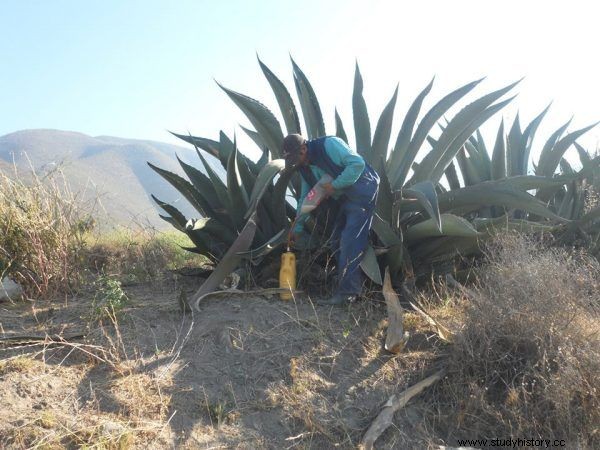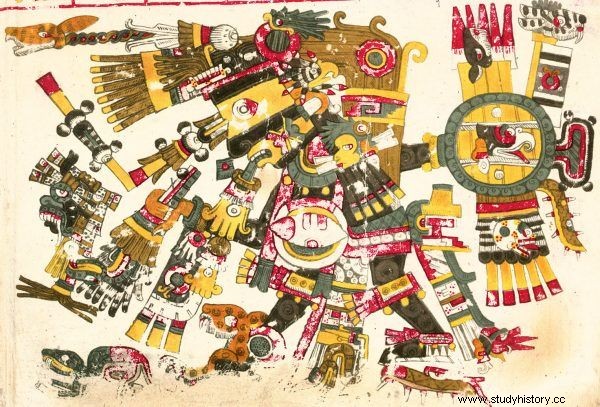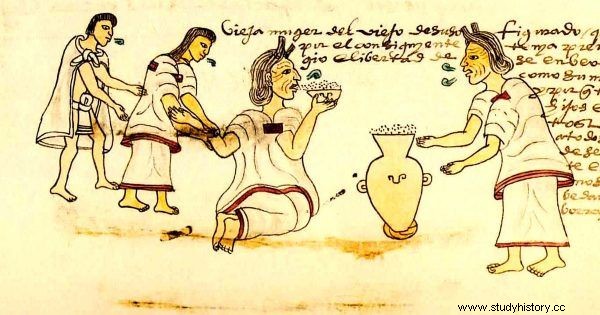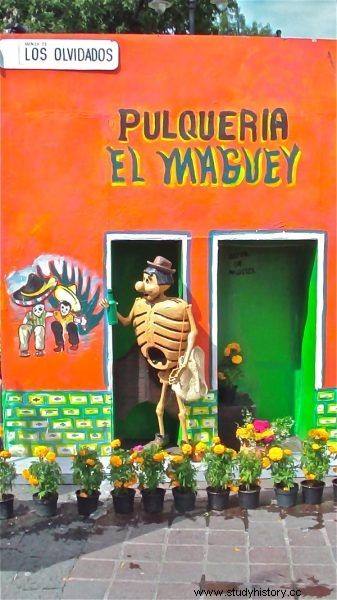The Aztecs specialized in mass human sacrifice and plucking the hearts of thousands of unfortunates. In one respect, however, they were very similar to the people of the 21st century. They liked good alcohol too. But how do you reconcile tequila attraction with ... the most radical prohibition in history?
The Aztecs, unlike the North American Indians, knew the technology of producing alcohol. The drink they tasted was called octli (or pulque ) and made from agave, just like tequila.
The center was cut from the mature plant, creating a cavity in which to collect the juice, which was then collected into the gourds. Later it was poured into large vats where it was fermented. The drink thus obtained had an alcohol content similar to that of beer or weak wine.
Besides alcohol octli contains valuable minerals and vitamins, incl. iron, phosphorus and vitamin C . However, as mentioned in the introduction, the average Aztec rarely enjoyed the taste of this drink. The reason was a few quite serious hits they passed after drinking octli Aztec gods.

As you can see, agave is a large plant (photo:Palmarito Tochapán, CC BY-SA 3.0).
Aztec heroes - alcohol problems
The first was Topiltzin Quetzalcoatl, the ruler-priest of the city of Tollan. Everything was fine until Tezcatlipoca appeared, who wanted to bring down the king with magic and lies.
One of his tricks was to appear in the form of an old man in Quetzalcoatl's palace, who was suffering from severe pains at the time. The crafty scam gave him octli as medicine.
The ruler liked the drink so much that he ordered his sister, who was also a priestess, to be brought in. Due to drunkenness, both of them failed to fulfill their religious duties, which caused the anger of the gods. Some researchers argue that the story is not about posts or sacrifices, but about incest by a drunk couple .
Another one who did not benefit from drinking was the mythical ruler of the Huasteks, a people inhabiting the areas of the Gulf of Mexico. Right after inventing octli he overdid it so much that he exposed himself to his fellow diners. He had to flee with his tribe all the way to the coast out of shame . The Huasteks did not seem to learn from their mistakes, as the Aztecs considered them extremely dissolute and drinkers.

Tezcatlipoca in a drawing from the Borgia Codex (public domain).
It is forbidden to eat not only in public places
As you can see, octli was considered a dangerous drink. Especially people born on a day named Ome Tochtli were to be at risk of developing alcoholism. (Two Rabbits). The drunkenness of such a person came as no surprise to anyone: So they said:so this is his rabbit. It was his sign of the day; thus the gods of guilt are manifested on him.
In numerous extant speeches that moralize alcohol consumption, it has been presented as the cause of misfortunes and downfall. Consumption of octli was limited to holidays or religious purposes. On such occasions, "drinks" were often made with the addition of hallucinogenic plants . This allowed for "journeys" and "contacts with the gods."
There were serious consequences for not drinking moderately. If a priest or high official got drunk in public, he was punished with death . However, if there were not too many witnesses, he could only lose his position.

Older people could drink octli without any problems (Picture from Codex Mendoza, public domain).
The plebeians had a bit easier. The first drunkenness was punished by a public shaving of the head and tearing down the house . Only the second resulted in death . The execution was carried out by stoning in the market square. Old men of both sexes were excluded from the ban. The condition for free access to alcohol was the age of 70 and grandchildren.
On the one hand, sources say that there are strict limits on drinking octli on the other hand, they provide many vivid descriptions of alcoholics and the effects of their addiction . There are even reports of low-quality drinks. The Spanish chronicler Bernardino de Sahagun describes the Aztec bustle as follows:
And he has no trouble with it [pulque] nor does he feel disgusted and do not become disturbed or nauseous even if there are only leftovers left, which are actually like loose lumps of dirt or full of mosquitoes - full of disgusting and rubbish . So she swallows it, sucks it, sucks it. Like a dog licking its lips.
This is how it usually happens:the law and the imperatives of morality to oneself, and life to itself.

Contemporary Mexican pulchería (photo:DavidGomezChiu, CC BY-SA 3.0).
Tradition is (not) lost
Currently octli it is better known as pulque and remains a popular drink in Mexico. There are even special venues called pulquerías where this alcohol is served. Unfortunately, this drink spoils quickly, which makes it difficult to transport. It also loses more and more often with other alcoholic beverages and its consumption is decreasing. It is also not profitable to export it. What a pity, you could taste a bit of pre-Columbian Mexico.
Bibliography:
- Frances Frei Berdan, Patricia Rieff Anawalt, The Essential Codex Mendoza , University of California Press, Berkeley 1997.
- Frances Frei Berdan, The Aztecs of Central Mexico. An Imperial Society , Wadsworth, Belmont, California 2005.
- Henry B. Nicholson Topiltzin Quetzalcoatl:The Once and Future Lord of the Toltecs , University Press of Colorado, Boulder 2001.
- Justyna Olko, Aztecs , series Mythologies of the world , New Media Concept, Warsaw 2007.
- Justyna Olko, Mexico before the conquest , PIW, Warsaw 2010.
- Jeffrey R. Parson, The Pastoral Niche in Pre-Hispanic Mesoamerica , [in:] Pre-Columbian Foodways. Interdisciplinary Approaches to Food, Culture, and Markets in Ancient Mesoamerica , ed. by John E. Staller, Michael Carrasco, Springer, New York 2010.
- Michael E. Smith, The Aztecs , Blackwell, Malden – Oxford 1996.
